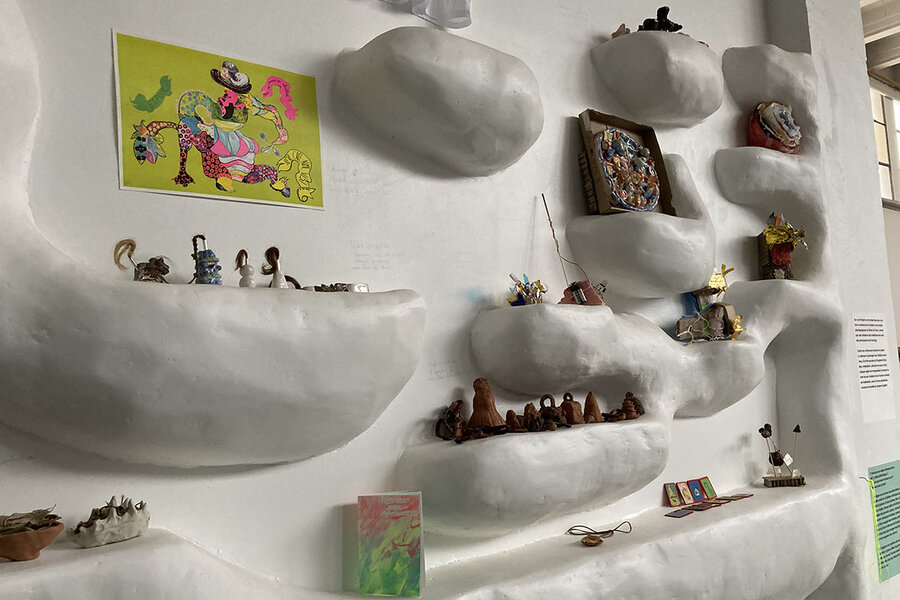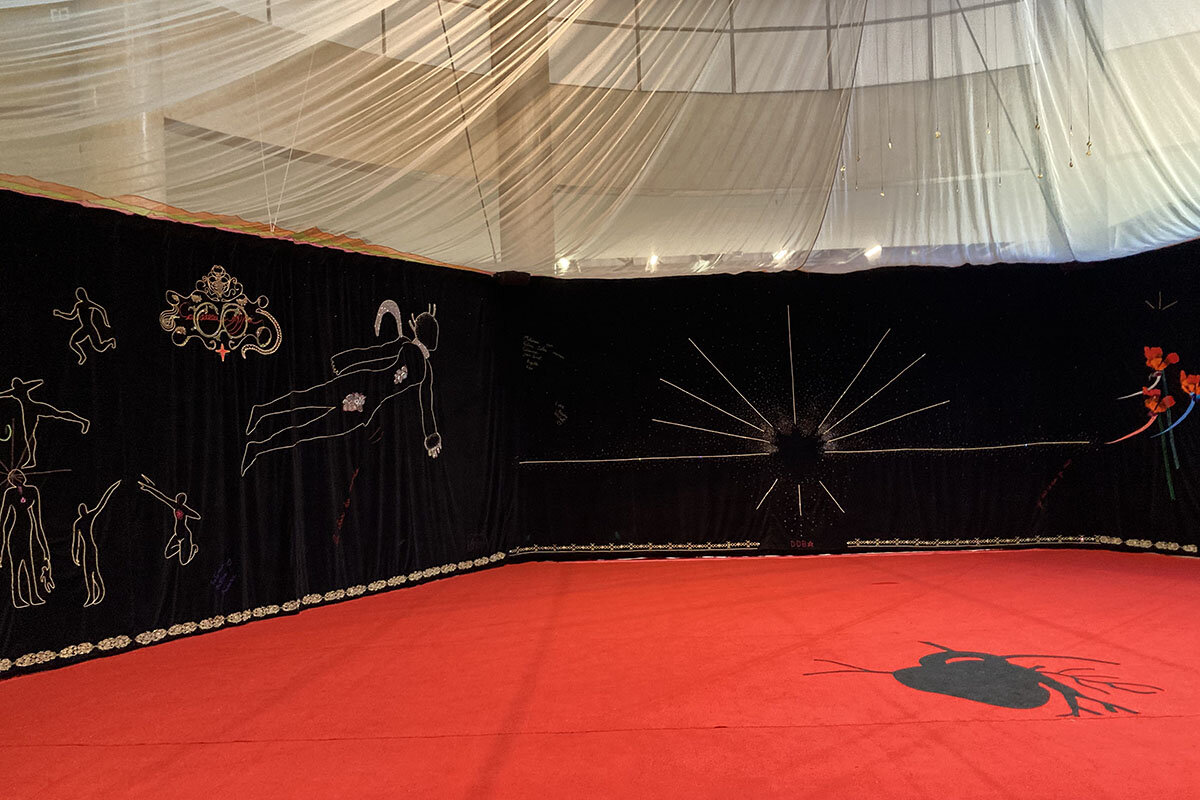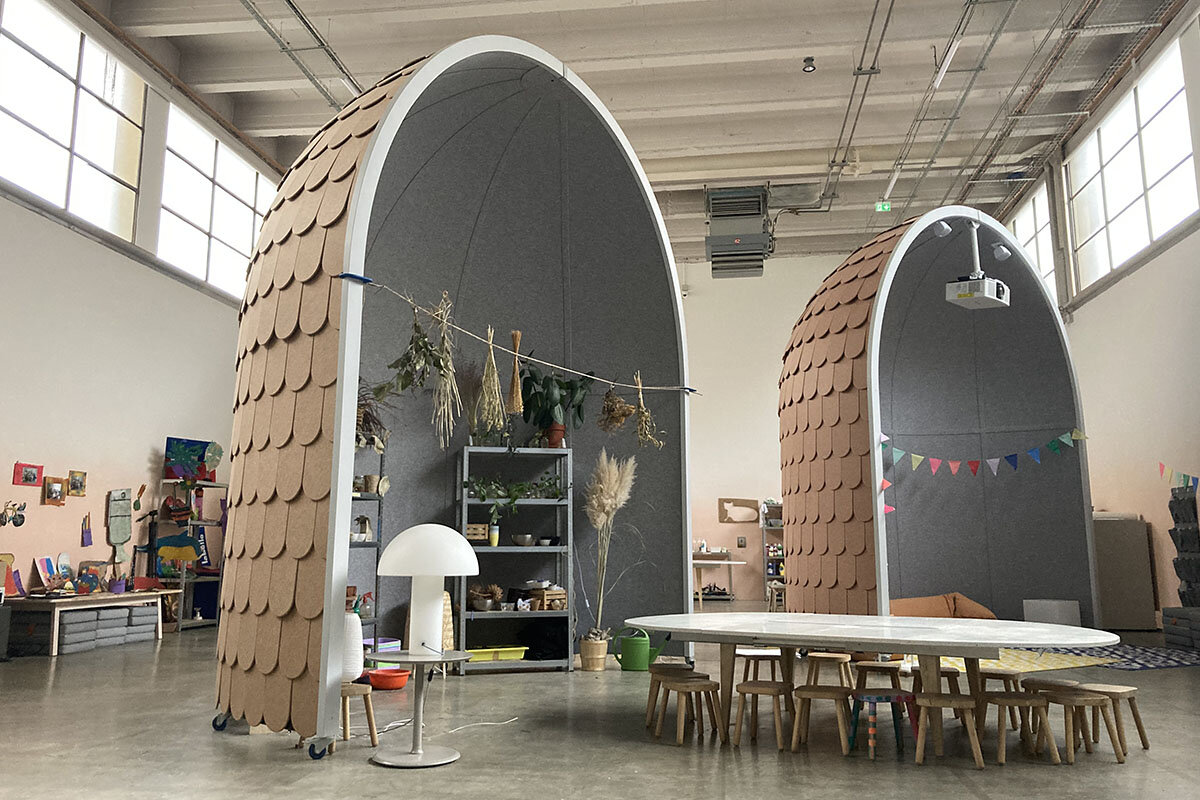In France, a new prescription for mental health: Museum visits
Loading...
| Paris
Tucked in the back of the Palais de Tokyo, a sweeping modern art museum in Paris, is a large studio. Called Le Hamo, like the French word for hamlet, it is just like its homophone – cozy and inviting. Wormlike ceramic shelving shows off amateur artwork: rust-colored clay figurines and sculptures made of old batteries, cardboard, and toothpicks.
Since September, small groups have come to the studio for art workshops, often in conjunction with visits to the museum. Today, four young people diagnosed with autism have just come from “Infinite Vessel,” by Algerian artist Dalila Dalléas Bouzar, next door.
Resident cultural mediator Lorraine Suty spreads a black cloth on the floor and hands out bits of white string, encouraging the group to re-create the artwork. A teenager in a mauve sweatshirt loops the string into squiggly lines, placing colorful cotton balls around the edges. Although he is nonverbal, a wide smile crisscrosses his face – just like it did during his encounter with the original piece.
Why We Wrote This
A story focused onCan going to a museum be therapeutic? A partnership of therapists, health care workers, and educators in France is creating pathways for doctors to “prescribe” museum visits and art interactions to those needing mental health care.
Le Hamo goes beyond traditional art therapy. It focuses instead on bien mieux – (feeling) much better – for those who are neurodiverse or struggling with mental health. It is part of a broader push across France to incorporate art, culture, and in-person museum visits in individual care plans.
France’s art world is taking a bigger role in public health, from mental health issues to chronic illness and disability, in order to help people find community and feel better. Advocates say museums can be more than one-way encounters with art. They can also be participatory, promote well-being, and help people move out of social isolation, depression, and anxiety – especially in the aftermath of the COVID-19 pandemic.
“Museums are these exceptional environments where everything is beautiful and you can slow down. It’s like walking through the forest,” says Nathalie Bondil, a pioneer in the field of museum therapy and the museum and exhibitions director at the Institut du Monde Arabe in Paris. “For many people, it’s not natural to go to a museum. But there’s something powerful about the direct confrontation with a piece of art, and that can have benefits on numerous levels.”
“A window into reverie”
The concept of museum therapy has existed since the 1980s, but it experienced a big boom in the 2010s. There were programs like Meet Me at the Museum of Modern Art in New York City, which helped people diagnosed with Alzheimer’s disease experience art from 2007 until 2014. And Montreal’s Museum of Fine Arts launched a comprehensive art therapy and education wing in 2017.
In France, the Palais des Beaux-Arts in Lille has employed art therapists since 2012. And Ms. Bondil, the museum director, has led a seminar on museum therapy for the last three years at the École du Louvre in Paris.
But until recently, much of art and museum therapy here has been siloed, with therapists, health care workers, and educators each working in their own corners without much coordination. That is slowly starting to change.
This past November, the Palais des Beaux-Arts and the Lille University Hospital signed an agreement for doctors to begin writing “museum prescriptions” to encourage patients to experience and practice art as part of their care plan.
And in January 2024, the Claude Bernard University in Lyon began offering the country’s first college degree in “cultural prescriptions,” in partnership with neurologists, psychologists, and arts professionals.
“A cultural prescription is an invitation to contemplate what you like: music, poetry, or art,” says Laure Mayoud, a psychologist and founder of L’invitation à la Beauté, a nonprofit that promotes culture as part of healing. “When you follow something you like, it liberates your neurotransmitters.”
Ms. Mayoud works with children in the Hôpital Lyon Sud, including those in end-of-life care, and she uses colors, perfume, and music as part of her therapy. If patients can’t leave their beds to go to a museum, she brings the artwork of their choice to them. “It takes you outside your own suffering,” she says. “It creates a window into reverie.”
“Art by prescription”
Although some of the museum therapy initiatives were already in the works prior to the COVID-19 pandemic, administrators have increasingly seen their relevance in the years since. The number of diagnoses of depression among French people of ages 18-24 has nearly doubled since 2017, according to an October 2023 study by France’s national public health agency. And psychiatric consultations among university students have risen by 30% in the past two years.
In 2022, the MO.CO. Contemporary Art Museum in Montpellier, France, created its project “Art sur ordonnance” – “Art by prescription” – with mental health in mind. In collaboration with the University Hospital of Montpellier, small groups, mostly made up of young people, visit exhibitions, meet artists, and engage in related workshops.
“Many of these people have broken with social and physical activities, and are no longer in touch with their emotions or what they like to do,” says Stéphanie Delpeuch, manager of public services at MO.CO. “They come here and can get back into life through art and culture.”
Museum operators say they want to use their spaces to help build community, which means adapting them to each group’s needs. That can translate to bringing groups into museum spaces when they are closed to the general public or selecting pieces ahead of time that will reduce anxiety, not add to it. One of the ultimate goals is to help participants re-create social links.
At the Palais de Tokyo, Le Hamo acts as a bridge between the health care sphere and the general exhibition area of the museum. That’s been an important part of participants’ personal care paths, which can look different for everyone, administrators say.
For the four young visitors diagnosed with autism, Le Hamo is a welcome respite after their morning visit to the museum. There, some members of the group wanted to touch the intricate beading and colorful threads on the tapestry of “Infinite Vessel” or lie down on the red carpet inside the gauzy tent. They were not allowed, but inside Le Hamo, interacting with art is not just permitted – it is the goal.
“The starting point is a person’s confrontation with art, but here, we can re-center our emotions, touch materials, discuss the art, and share a moment together,” says Marion Buchloh-Kollerbohm, head of cultural mediation at the Palais de Tokyo. “It’s all about inclusion, exchange, and finding common ground.”








